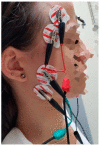Electromyographic Patterns of Masticatory Muscles in Relation to Active Myofascial Trigger Points of the Upper Trapezius and Temporomandibular Disorders
- PMID: 33805008
- PMCID: PMC8063936
- DOI: 10.3390/diagnostics11040580
Electromyographic Patterns of Masticatory Muscles in Relation to Active Myofascial Trigger Points of the Upper Trapezius and Temporomandibular Disorders
Abstract
The presented study aimed to analyze and compare the electromyographic patterns of masticatory muscles in subjects with active myofascial trigger points (MTrPs) within upper trapezius, patients with temporomandibular disorders (TMDs) and healthy adults. Based on the diagnostic criteria of MTrPs according to Travell & Simons and the Research Diagnostic Criteria for Temporomandibular Disorders, 167 people were qualified for the study. Subjects were divided into 3 groups: with active MTrPs in the upper trapezius, with diagnosed temporomandibular disorders (TMDs) and healthy adults. Measurements of the bioelectric activity of the temporalis anterior (TA) and masseter muscle (MM) were carried out using the BioEMG III ™. Based on statistical analysis, significantly lower values of TA resting activity were observed among controls in comparison to MTrPs (1.49 μV vs. 2.81 μV, p = 0.00) and TMDs (1.49 μV vs. 2.97 μV, p = 0.01). The POC index values at rest differed significantly between MTrPs and TMDs (86.61% vs. 105%, p = 0.04). Controls presented different electromyographic patterns within AcI in comparison to both MTrPs (4.90 vs. -15.51, p = 0.00) and TMDs (4.90 vs. -16.49, p = 0.00). During clenching, the difference between MTrPs and TMDs was observed within MVC TA (91.82% vs. 116.98%, p = 0.02). TMDs showed differences within AcI in comparison to both MTrPs group (-42.52 vs. 20.42, p = 0.01) and controls (-42.52 vs. 3.07, p = 0.00). During maximum mouth opening, differences between MTrPs and TMDs were observed within the bioelectric activity of masseter muscle (16.45 μV vs. 10.73 μV, p = 0.01), AsI MM (0.67 vs. 11.12, p = 0.04) and AcI (13.04 vs. -3.89, p = 0.01). Both the presence of MTrPs in the upper trapezius and TMDs are related to changes in electromyographic patterns of masticatory muscles.
Keywords: electromyography; masseter muscle; myofascial pain; myofascial trigger points; temporalis anterior; trapezius.
Conflict of interest statement
The authors declare no conflict of interest.
Figures
Similar articles
-
Cervical Myofascial Pain Is Associated with an Imbalance of Masticatory Muscle Activity.Int J Environ Res Public Health. 2022 Jan 29;19(3):1577. doi: 10.3390/ijerph19031577. Int J Environ Res Public Health. 2022. PMID: 35162600 Free PMC article.
-
The Difference in Electromyographic Activity While Wearing a Medical Mask in Women with and without Temporomandibular Disorders.Int J Environ Res Public Health. 2022 Nov 23;19(23):15559. doi: 10.3390/ijerph192315559. Int J Environ Res Public Health. 2022. PMID: 36497634 Free PMC article.
-
Novel Functional Indices of Masticatory Muscle Activity.J Clin Med. 2021 Apr 1;10(7):1440. doi: 10.3390/jcm10071440. J Clin Med. 2021. PMID: 33916147 Free PMC article.
-
Proximal myofascial pain in patients with distal complex regional pain syndrome of the upper limb.J Bodyw Mov Ther. 2019 Jul;23(3):547-554. doi: 10.1016/j.jbmt.2019.02.015. Epub 2019 Feb 21. J Bodyw Mov Ther. 2019. PMID: 31563368 Review.
-
The prevalence of myofascial trigger points in neck and shoulder-related disorders: a systematic review of the literature.BMC Musculoskelet Disord. 2018 Jul 25;19(1):252. doi: 10.1186/s12891-018-2157-9. BMC Musculoskelet Disord. 2018. PMID: 30045708 Free PMC article.
Cited by
-
Myopia & painful muscle form of temporomandibular disorders: connections between vision, masticatory and cervical muscles activity and sensitivity and sleep quality.Sci Rep. 2023 Nov 19;13(1):20231. doi: 10.1038/s41598-023-47550-6. Sci Rep. 2023. PMID: 37981640 Free PMC article.
-
Effects of visual input on changes in the bioelectrical activity of the cervical and masticatory muscles in myopic subjects.Sci Rep. 2022 Jun 8;12(1):9435. doi: 10.1038/s41598-022-13607-1. Sci Rep. 2022. PMID: 35676313 Free PMC article.
-
Masticatory Muscle Thickness and Activity Correlates to Eyeball Length, Intraocular Pressure, Retinal and Choroidal Thickness in Healthy Women versus Women with Myopia.J Pers Med. 2022 Apr 13;12(4):626. doi: 10.3390/jpm12040626. J Pers Med. 2022. PMID: 35455742 Free PMC article.
-
Cervical Range of Motion Analysis Performed with an Accelerometer: A Study of Intersession Reliability for Dental Practice.Healthcare (Basel). 2023 May 15;11(10):1428. doi: 10.3390/healthcare11101428. Healthcare (Basel). 2023. PMID: 37239714 Free PMC article.
-
Prevalence of Clinical Signs and Symptoms of Temporomandibular Joint Disorders Registered in the EUROTMJ Database: A Prospective Study in a Portuguese Center.J Clin Med. 2023 May 18;12(10):3553. doi: 10.3390/jcm12103553. J Clin Med. 2023. PMID: 37240658 Free PMC article.
References
-
- Simons D.G., Travel J.G., Simons L.S., Cummings B.D. Myofascial Pain and Dysfunction: The Trigger Point Manual. 2nd ed. Lippincott Williams & Wilkins; Philadelphia, PA, USA: 1998.
-
- Gerwin R. Myofascial Pain Syndrome: Here We Are, Where Must We Go? J. Musculoskelet. Pain. 2010;18:329–347. doi: 10.3109/10582452.2010.502636. - DOI
-
- Zhuang X., Tan S., Huang Q. Understanding of Myofascial Trigger Points. Chin. Med. J. 2014;127:4271–4277. - PubMed
LinkOut - more resources
Full Text Sources
Other Literature Sources
Medical


